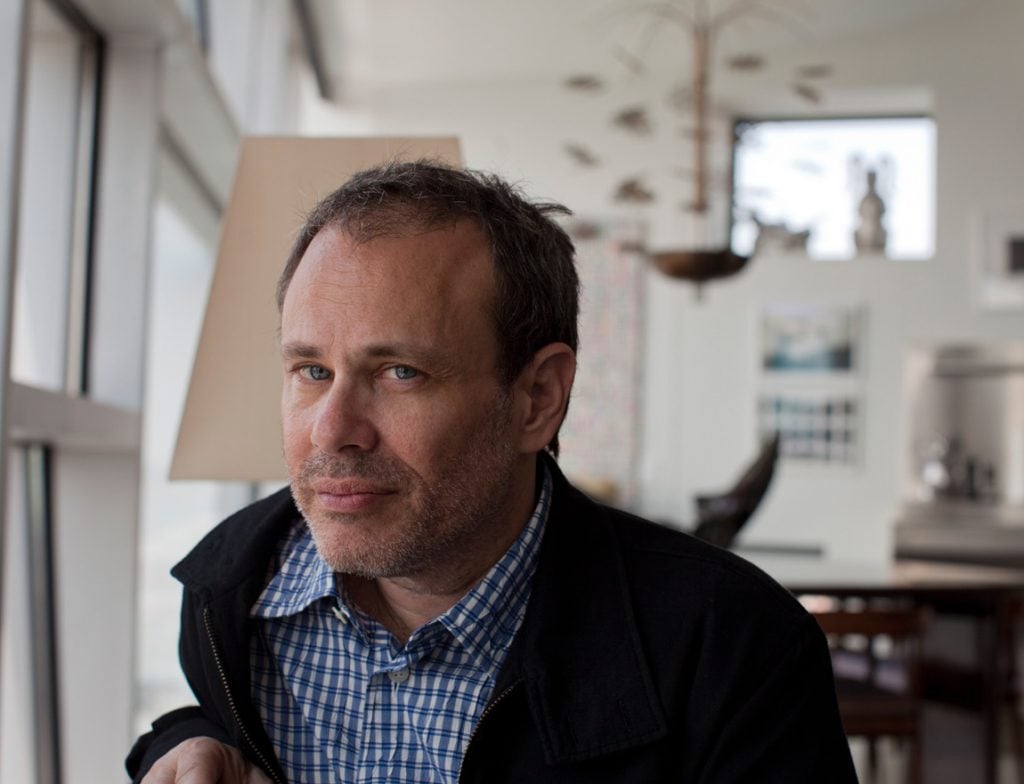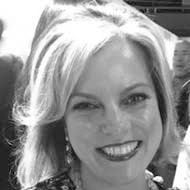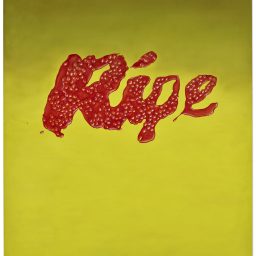Allan Schwartzman has had a singular path in the art world. He started out as a curator at the nascent New Museum in New York in 1977, spent more than a decade as a freelance art writer, and then went on to have a lucrative career as an influential yet low-profile art advisor.
His unexpected partnership with market dynamo Amy Cappellazzo in 2014 led to an even bigger coup, when their Art Agency, Partners was acquired for $85 million by Sotheby’s in 2016. At the auction house, Schwartzman continued advising clients, led the sweeping redesign of Sotheby’s galleries, and produced newsletters and podcasts with journalist Charlotte Burns. He also shepherded a number of key consignments for auction, including Jean-Michel Basquiat’s Untitled (1982), which remains the artist’s $110.5 million record.
Schwartzman, 65, is a thinking man’s market maker, with a track record for digging up undervalued artists and dreaming up art Shangri-las for his collector clients. Quiet but opinionated, he can be often spotted in a hoodie and sneakers.
Since Schwartzman left Sotheby’s in 2020, I’ve been dying to find out more about his next step. He’s been mum—until now. This week, we spoke over two days by phone about his new advisory firm, Schwartzman&, his controversial role on the advisory council for Saudi Arabia’s culture ministry, and of course the unprecedented state of the art market. Below is a condensed version of our conversations.

Paintings by Claude Lawrence at the Schwartzman& offices in Chelsea. Courtesy of Schwartzman&.
Let’s start with Schwartzman&. You’ve been quietly gaining steam. I’ve been to a couple of parties at your new home on West 22nd Street, Dia’s former administrative offices; listened with great interest to the documentary podcast series, Hope and Dread, you produced with Studio Burns; and attended the Talking Galleries symposium you co-hosted this spring. So many different initiatives. What exactly is Schwartzman&?
When I left Sotheby’s, I was fortunate to be able to leave with clients and staff. It was the beginning of the pandemic and it was a time of great disruption and change and anticipation about change. And so I wanted to step back and take my time in thinking through what we do and how we do it.
It was important to me that we be looking at the wider ecosystem of the art world and see how our advisory work could be extended beyond the collector. I’ve had the opportunity through the years to work on quite a number of projects that have fallen outside of what art advisors traditionally have done, like museum advisory and philanthropy. I’ve helped to conceive several significant philanthropic funds for the benefit of both institutions and artists. I’ve always helped artists quietly, behind the scenes, when they’ve turned to me for some guidance in various matters related to the market.
Collectors are the core of the business—we probably have about 20 or so clients. Artists and foundations would probably be another 20. We have a staff now of somewhere between 18 and 20 people.
For the art market, that’s a pretty large business. It certainly is for an advisory, which is traditionally just an individual, not a corporation. Your name is on the door, and yet some of your staffers, like Simon Preston and Augusto Arbizo, have had their own galleries in the past. How does it work?
While we have a larger staff than most other advisory services, it’s not a more corporate structure. I am in the lead on some projects, but not most projects. Every collector we work with is advised by a team of three to four people. Every client can have their needs attended to at any moment, regardless of my availability.
Simon Preston, who had his own gallery, runs the artist advisory. I also knew that we would benefit from having one person whose primary job is to stay in contact with galleries, stay on top of what’s interesting, and what’s out there in the world. So that things don’t fall between the cracks in our research for clients and in the scope of art that we have access to for them. That’s Augusto’s role.
What I wanted in this current phase is to have both long-term staff and younger staff be able to develop their own clientele on which they take the lead, but to be pursuing the work in a collaborative way.

Robert Rauschenberg, Untitled (Early Egyptian) (1973). © Robert Rauschenberg Foundation, Courtesy the foundation and Gladstone Gallery. Licensed by VAGA at Artists Rights Society (ARS). Photography by Ron Amstutz
What are some of the key projects you’ve undertaken so far?
The first artist project we took on was advisory work for the Rauschenberg Foundation and you can see the first visible signs of that in the exhibitions that are up now [at Gladstone and Mnuchin galleries in New York].
Rauschenberg is certainly the most undervalued, significant artist of the latter part of the 20th century and 21st century. And you have a foundation whose great wealth is in work by Rauschenberg, particularly works from the latter half of his artistic development. I always had a misunderstanding about the last decades of his work and so has the market.
It’s so true—despite the work of several mega-galleries like Gagosian and Pace, Rauschenberg’s auction prices are a fraction of peers Jasper Johns and Andy Warhol. What’s the main challenge in repositioning someone like Rauschenberg?
The dependence of the art market on data. The statistics that appear on your very database often have become an amazing resource, but they’ve also become a kind of self-fulfilling misunderstanding. And so with an artist like Rauschenberg, who worked in many different ways across the decades, it was pretty hard to pin him down. What performed well at auction are the combines and the silkscreen paintings.
And so it reinforced this assumption: Rauschenberg was only important in this very limited time period of the late ‘50s and early ‘60s. And when I started going through the warehouse, we saw an extraordinary range. It really was a kind of awakening.
Can you say what other artists and estates you advise?
We are advising the estates of Conrad Marca-Relli, Ad Reinhardt, and Jimmy Durham. We are working with Claude Lawrence, who you’ve probably never heard of, but you saw some paintings at our office. He’s a man in his late seventies who was known as a jazz saxophonist. His first exhibition just occurred at Eric Fischl and April Gornik’s artist residency program in Sag Harbor and he just had a show with Anthony Meier Fine Arts in San Francisco. He’s a very mature painter of great versatility and range.
Ultimately, the great patrons of the future are going to be artists and artist estates. In the 1950s, there were a few dozen contemporary artists living in New York. At the beginning of the 1960s, there were thousands of them. The first wave of baby boomer artists are now in their seventies and eighties. They may not be performing at ultra levels at auction, but they have made significant art that has a potential to rise in value to then fund other things. Simply look at the wealth in the Andy Warhol Foundation. I mean, the Warhol Foundation does more essential funding of contemporary art in this country than the National Endowment for the Arts.
That’s just one foundation. You multiply that by 10, and you’ve got a force. You multiply that by 100, maybe not at the same value level, but these things do compound. You’ve got real power in that.

MOCA Director Philippe Vergne, Allan Schwartzman, and Barbara Gladstone at MOCA Grand Avenue on October 15, 2016. (Photo by Donato Sardella/Getty Images for MOCA)
You often work with people who are your friends, like Rauschenberg Foundation director and former MoMA curator Kathy Halbreich. There could be a perception of things being too cozy almost.
Someone once said to me that at a certain point, your friends become the major museum directors. Kathy is a good friend. She’s someone I’ve known since before there was a market for contemporary art.
The art world was small when I entered it. It consisted first and foremost of artists and then of critics and curators. That was it. There were a few dealers, but there was hardly any market to speak of for younger artists. It was a community. That grounding has carried me through everything that I’ve done.
There are a number of museum directors that I have very strong and long-term relationships with. It’s not in any way a process of nepotism or cliquishness. It’s really the opposite—it’s that we share similar values. And where there are common values, there’s trust.
We have just come out of a record auction season, with $2.7 billion in art sold in two weeks in New York. There’s so much heat in the emerging art sector. How much is too much to pay for an untested artist?
Well, apparently according to this market, there isn’t too much to pay. As we’ve seen in the performance of the most recent evening auctions of 21st century art. There are many people out there collecting who have vast amounts of money—whether they’re paying $50,000 or $1.5 million, they want it and they want it now. So you have vast wealth in which the dollar doesn’t really mean much and [there’s] an expectation and probably a history of seeking instant gratification. We don’t have those clients.
In most instances, we have been able to get access to what our clients have wanted in the primary market.
There are a number of situations where, to get access to the best works by an artist, you are obliged to donate something [else] to a museum. In my assessment, paying twice the price to get the best work and to donate work in the process is actually not overpaying. It’s actually a wise way to go.
I think the question to ask is, are the things that are selling in these evening sales that extraordinary? Or is there a lot of work made by each of these artists of similar quality and are such prices sustainable over a long period of time?
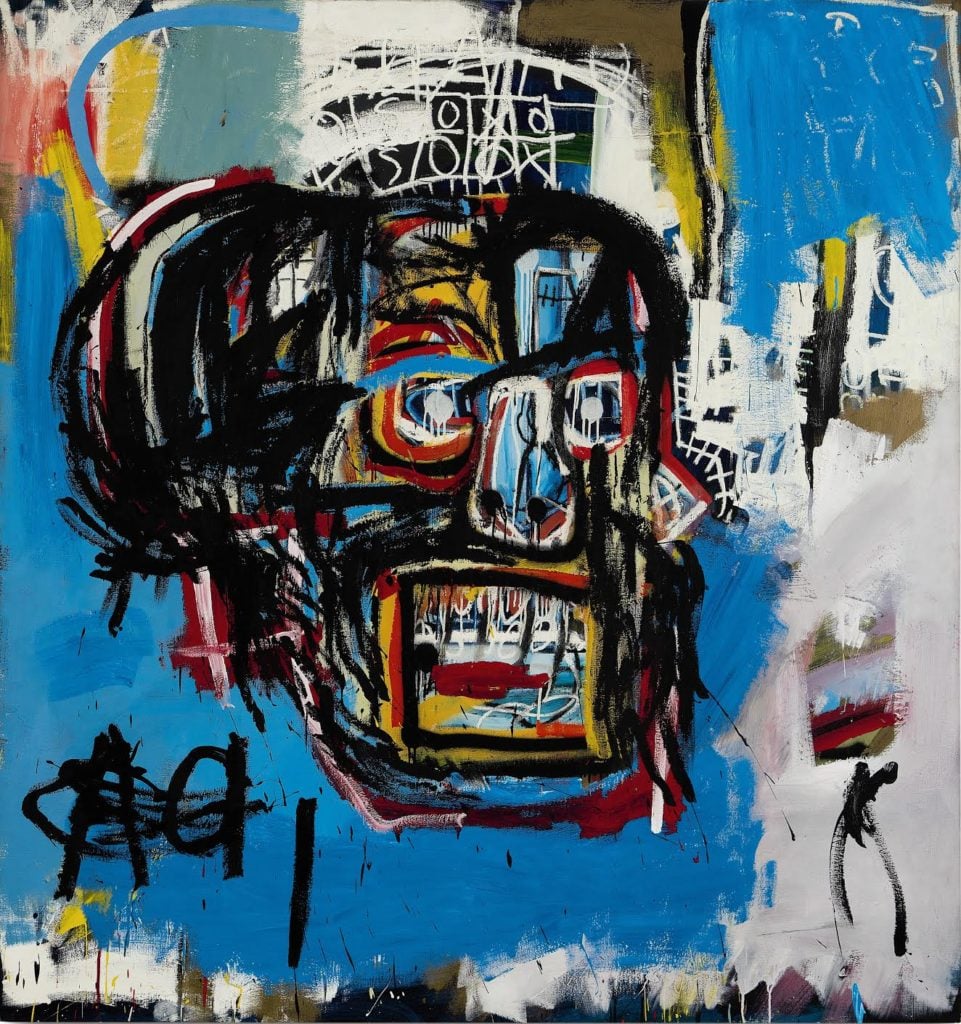
Jean Michel-Basquiat, Untitled (1982). Courtesy of Sotheby’s New York.
What do you think?
I think right now the demand is such that the people buying the work don’t really care. They want what they want, when they want it.
There are unprecedented numbers of people seeking the artists for whom there’s the greatest demand. It’s like there’s too many people and not enough food to feed them. You now have entire evening auctions of artists, most of whom most people had never heard of prior to seeing them in that evening auction.
It’s gotten to a point when before there’s the first exhibition, the galleries are oftentimes stating they’re only taking interest or they’re prioritizing interest for museum acquisition.
Things are pretty crazy on the primary market, too. The waiting lists that go into hundreds of people, and “BOGO” arrangements—”buy one, give one”—are ubiquitous. What advice do you give your clients?
There’s no such thing as a waiting list where people get a number and then when your number gets called, you get a painting. There are so many other factors that enter into who gets preference for work. The demand is so much greater at this point, first amongst most significant established collectors, then amongst very notable collectors who are emerging as rapidly as the artists they are pursuing.
That’s always the big question when a new potential client comes to us: How do I know I’m not going to be third?
How do you make sure that all your clients are treated fairly?
You know, we have probably half of our clients who have collected [Gerhard] Richter for example, but they have focused on his work at different times within their collecting cycle.
When it comes to the work of emerging artists, sometimes we have several clients interested in the work at the same time, and we actually benefit from having multiple interests because it puts us in a great position in relation to the gallery for access. The only time we’ve had direct conflict, it was for work that was photographic and therefore came in an edition.
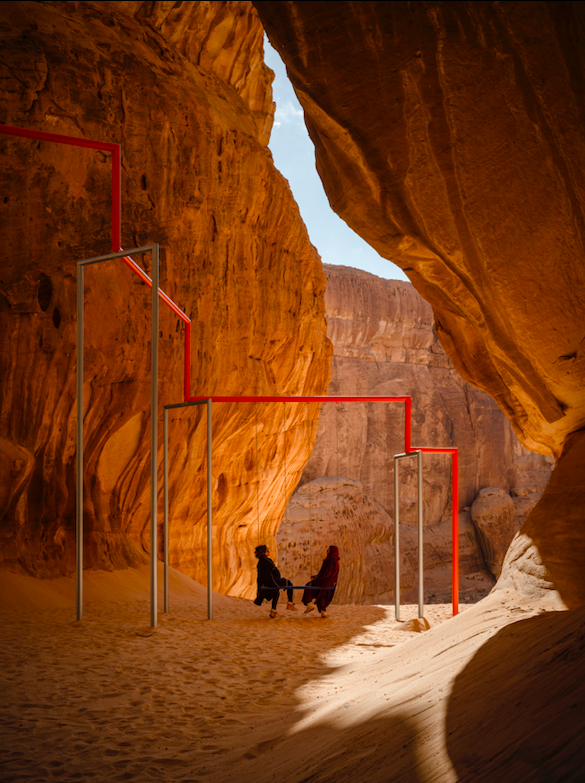
Superflex, One Two Three Swing! Installation view at Desert X AlUla, photo Lance Gerber, courtesy the artist, RCU and Desert X
Some of your advisory work has been controversial. In 2017, you joined the advisory board for the Royal Commission for AlUla, a region in Saudi Arabia where major cultural and tourism developments are taking place. How do you respond to people who would call these plans whitewashing by a repressive regime?
AlUla is the most extensive terrain anywhere in the world of unexplored archaeological remains of pre-Islamic cultures. If you look at the nations to the north, virtually all of them, from Lebanon through Syria, Iraq, and Afghanistan, have had their pre-Islamic history destroyed in recent years by radical fundamentalist groups. In Saudi Arabia, you have a very different approach, which is to embrace this earlier history that had previously not been widely known within the country and that certainly has not been a site of significant visitation. They chose this as the central focus of their tourism development precisely because it is a crossroads of cultures historically, and their interest in involving contemporary art is to be engaging today as a place of crossroads and exchange. So that has a potential to transform thinking, tolerance, openness, and content across the board. I do believe in the transformative power of art and I see a very sincere and dedicated commitment to that.
